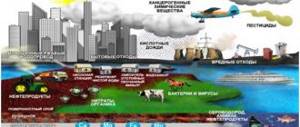presentation for a lesson on the topic “Food hygiene” presentation for a biology lesson (8th grade) on the topic
Slide 1
“Food Hygiene” Municipal Educational Institution Secondary School No. 82, Saratov Biology teacher: Artamonova M.V.
Slide 2
Goal: Continue to develop students’ knowledge in the field of healthy nutrition; understanding that health is the basis of an interesting, productive life, and the basis of health is proper nutrition.
Slide 3
Objectives: 1. Formation of students’ understanding of food and nutrients. 2. Formation of correct guidelines for the choice of food products, for the organization of the nutrition process as a whole. 3. Justification of food hygiene rules.
Slide 4
food Source of energy Source of nutrients Source of vitamins What role does food play in human life?
Slide 5
Food products are products of animal and plant origin, used in both processed and unprocessed forms in human nutrition.
Slide 6
Nutrients are vital components of food, used by the body as material for building the living matter of cells and serving as a source of energy necessary for its life (proteins, fats, carbohydrates, etc.)
Slide 7
Write food items in the right column and nutrients in the left column. Cabbage, beans, butter, mineral salts, rice, sausage, carbohydrates, bread, lard, cream, fat, protein, vitamins, fish, meat. Food Nutrients
Slide 8
Healthy eating In the modern world, much attention is paid to the problem of proper nutrition. It was found that each person has his own individual diet, which depends on his age, weight, health, physical activity and other factors.
Slide 9
TEST AM I EATING CORRECTLY?
Slide 10
Principles of healthy eating Moderation It is necessary to maintain a balance between the energy received from food and the energy consumed in the process of life. It has been established that, on average, the basal metabolism expends about 1 kcal per 1 kg of body weight per 1 hour. In people who constantly experience physical activity, the basal metabolism, as a rule, increases within 30%. Diversity The population of our planet uses thousands of food products and even more culinary dishes for nutrition. The energy value of the diet depends on the proteins, fats, carbohydrates, vitamins, minerals and water it contains. The optimal ratio of proteins, fats and carbohydrates in the diet of a healthy person is close to 1:1.2:4. Diet The diet of a person is usually regulated by appetite. But it is necessary to keep in mind that appetite persists even after eating. This is due to the need to digest and absorb nutrients. And only after they begin to enter the bloodstream, the excitation of the food center begins to give way to its inhibition.
Slide 11
Nutrition for schoolchildren and adolescents During school and adolescence, children undergo sexual development; they grow rapidly, gaining weight and muscle strength. Sports and physical labor lead to a sharp increase in energy expenditure. The nervous system of children of this age is in a state of significant tension under the influence of intense cognitive information and the complexity of school learning. That is why it is so important to provide schoolchildren and adolescents with nutritious food and to properly organize their diet. It is advisable to include dietary butter and sour cream in the diet. Schoolchildren should receive meat, milk, dairy products, vegetables, fruits, and bread daily. In the morning you can give a snack (salad or cheese, sausage), then a meat or fish dish with a side dish or porridge, cottage cheese or egg dishes, tea, milk, coffee, bread and butter. For lunch - salad or vinaigrette, soup, meat or fish with a side dish, compote or juice. In the afternoon - milk, kefir, pastries, fruit. For dinner - dishes from cottage cheese, vegetables, eggs and drinks. At this age, unfortunately, children often violate their diet, eat randomly, often dry food, on the go. These bad habits have a detrimental effect on the growing body. Parents should teach their children how to eat from early childhood!
Slide 12
Food hygiene rules
Slide 13
Every meal should start with raw vegetables or fruits. Vegetables and fruits eaten on an empty stomach stimulate the functioning of the digestive glands, gastrointestinal motility, and help normalize the intestinal microflora.. Eating fruit for dessert is harmful!
Slide 14
Chew your food thoroughly. When chewing, not only mechanical grinding of food occurs, but also partial breakdown of carbohydrates and some proteins under the action of enzymes contained in saliva.
Slide 15
Do not drink immediately before, during or immediately after meals. You should drink at least half an hour before meals and no earlier than an hour after meals.
Slide 16
Avoid very cold (well below room temperature) and very hot (burning your mouth and lips) food and drinks. Immediately after eating, do not start working, but rest a little. The break should be at least 15 minutes in case of light physical work and at least half an hour in case of heavy physical work.
Slide 17
Eat slowly, take breaks between dishes - at least 5, and preferably 10 minutes. Breakfast and dinner should last at least half an hour, lunch - at least 40 minutes.
Slide 18
Let's play? Game "Agree - Disagree." Is it true that you should drink 2 glasses of milk every day? Is it true that in the summer you can stock up on vitamins for the whole year? Is it true that milk is healthier than yogurt? Is it true that citrus fruits contain a lot of vitamin C? Is it true that bananas lift your spirits? Is it true that chewing gum preserves teeth?
Slide 19
Obesity
Slide 20
This is interesting (super heavyweights) Men Ion Brower Minnock (1941-1983) USA 185cm 635kg Michael Walker (1934) USA 188cm 538kg Women Percy Pearl (1926 1972) USA 183cm 399.1kg Ida Maitland (1898-1932) USA 413.2kg
Slide 21
Diabetes mellitus The main source of energy for humans is glucose. It comes with food and is delivered to all cells of the body. The absorption of glucose depends on the pancreatic hormone insulin. A condition in which the concentration of glucose in the blood exceeds the norm is called diabetes mellitus.
Slide 22
Allergies A person needs the immune system to protect him from infection. However, sometimes she becomes too sensitive and begins to fight substances that are found everywhere in nature. Allergy is a state of increased sensitivity of the body to any substance.
Slide 23
THANK YOU FOR YOUR ATTENTION!!!
Measures to prevent viral infections. Hygiene issues
Ahead of us is a new school year, new safety measures proposed by Rospotrebnadzor for schools, and new impressions from our favorite work, colleagues and friends. As follows from the text of the document, in addition to measuring the temperature at the entrance to the school and the disinfection regime, additional restrictions will be introduced in schools aimed at minimizing contacts between students. Teachers in each individual organization have already received instructions from management on how the educational process will be organized in their school. Depending on the number of students and the capabilities of the teaching staff, they vary, but come down to common ideas: fewer students in the class, less movement around the school, a reduction in additional classes and public events.
We have collected in a single article the simplest recommendations on the prevention of viral infections. They can be used to generate messages in school groups and to update information stands. Separately, we provide a link to the Full text of Rospotrebnadzor recommendations No. 02/8900-2020-24 dated 05/08/2020 (text version of the document)
Measures to prevent viral infections
So, Rosobrnadzor specifically advises following extremely simple rules:
- to wash hands;
- wear a mask;
- limit contact with sick people;
- At the slightest sign of discomfort, consult a doctor.
Let's look at each point in more detail.
How to wash your hands correctly?
Let's start with a simple question: after what actions should you wash your hands to reduce the possibility of getting sick from anything?
- Before, during and after cooking.
- Before eating.
- After contact with people in public places.
- After contact with objects in public places (table, tray, handrail, stairs, pole, bench, etc.).
- Before and after treating a cut or wound.
- After using the toilet.
- Before and after you changed your baby's diaper or cared for him.
- After blowing your nose, coughing or sneezing.
- After touching an animal, food or animal excrement.
- After touching the garbage.
Washing your hands is easy and one of the most effective ways to prevent the spread of germs.
Just imagine how long the chain of touches can be: cat - child - mom - dad - colleagues at work - their relatives and friends. You can even play a game during the lesson: let the children count how many people can get harmful germs from them if their hands remain dirty. Use our infographic to wash your hands like a doctor, i.e. very carefully:
To ensure maximum safety, it is recommended to use disposable paper towels.
You can also follow these 5 steps every time:
- Wet your hands with clean running water (warm or cold), turn off the tap with your elbow, and apply soap.
- Lather your hands by rubbing them together with soap. Rub the backs of your hands, between your fingers and under your nails.
- Rub your hands for at least 20 seconds. Need a timer? Sing the "Happy Birthday" song from start to finish twice.
- Wash your hands thoroughly under clean running water.
- Dry your hands with a clean, disposable towel, or air dry them (the second option is less hygienic when it comes to public places).
How to disinfect your hands?
Let's be objective, you may not always have access to a running water tap.
In this case, use an alcohol-based hand sanitizer (at least 60% alcohol). This product is sold in small bottles of 50 ml, or in large ones - up to a liter; you can find alcohol wipes in pharmacies and cosmetics stores. Sanitizers can quickly reduce the number of germs on your hands in many situations. However, they do not get rid of all types of germs (even though they say 99.9%). Additionally, sanitizers may not be as effective when hands are visibly dirty or oily. In this case, you must first wash your hands and then apply the gel. One more thing: Hand sanitizers may not remove harmful chemicals like pesticides and heavy metals. We hope you and your students do not encounter this.
How to use hand sanitizer:
- Apply the gel to the palm of one hand (read the label to find out the correct amount);
- Rub your hands together;
- Rub the gel over the entire surface of your hands and fingers until the skin is dry. This should take about 20 seconds.
How to wear a mask correctly?
Note:
If you are NOT sick, you do not need to wear a face mask at all times except when in crowded groups (less than 1.5m). You should wear it if there was a risk of infection, but symptoms have not yet appeared, and also if you are not caring for a patient. Face masks may be in short supply, but they should be made available to caregivers in health centers.
How to behave correctly in public places?
- Avoid close contact.
- Avoid close contact with sick people. When you are sick, keep your distance from others so that they don't get sick too.
- In stores, do not go close to the crowd, try not to come to public places during rush hour, so as not to end up in queues or dense crowds.
Stay home when you are sick.
If possible, stay home from work, school, or running errands.
This will help prevent you from spreading your illness to others. Moreover, this will help you not get sick: warmth and peace are not just requests from doctors, it is their requirement! If you are sick with a flu-like illness, the CDC recommends that you stay home for at least 24 hours after you develop a fever unless you need medical care or other essential supplies. How to understand that you are not dangerous? The fever should subside within 24 hours without the use of fever-reducing medication.
Close your mouth and nose
Cover your mouth and nose with a tissue when coughing or sneezing. You can sneeze into the crook of your elbow, but not to the side or down - drops of your liquids can be transmitted to others. Influenza and other serious respiratory illnesses, such as respiratory syncytial virus (RSV), whooping cough and severe acute respiratory syndrome (SARS), are spread by coughing, sneezing or unclean hands.
Disinfect your hands with a pocket sanitizer after contact in public places.
Do not touch your eyes, nose or mouth.
It is much easier for microbes to “win” if you touch your face, nose or other parts of the face with dirty hands. If a microbe could only get from your hand to die under the pressure of soap, then once it gets into the mucous membrane - into the eye, nasal or oral cavity - it almost achieved my main goal.
Practice other healthy habits
Clean and disinfect frequently used surfaces at home, work or school, especially when someone is sick.
These include: tables, doorknobs, light switches, countertops, telephones, keyboards, toilets, faucets and sinks, telephones. Get enough sleep, be physically active, manage stress, drink plenty of fluids and eat nutritious foods. Even coronavirus statistics show that people with reduced immunity are at risk. It's time to raise it by all means.




